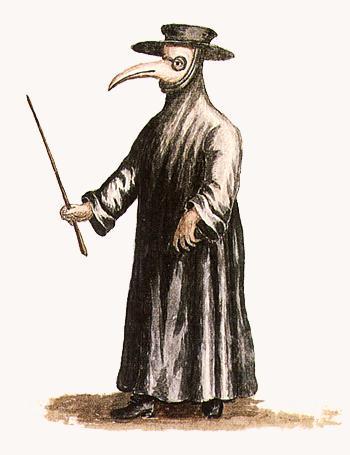This is quickly just becoming a random facts blog, but there are so many cool things I keep finding! This time I was simply drawn in by the strange costume that these guys wore. Take a look:
Can you imagine being sick and then having this guy come knocking on your door?
So these people were essentially doctors hired to treat people during outbreaks of the bubonic plague. Their work was paid for by the government and so they were able to treat both the wealthy and the poor. Unfortunately some were known for charging extra for false "miracle cures" and the like.
Generally speaking these doctors were not professionally trained surgeons. Usually they were younger doctors seeking to establish themselves or second rate doctors who were struggling to create their own businesses.
It is believed that the long wooden cane was either used to keep patients at a distance or to move them around when necessary. Probably both.
The hats were generally worn by physicians of the time and so was symbolic of the doctor's purpose.
Probably the earliest textual description of the mask dates back from the 17th century. Charles de Lorme, who was chief physician to Louis XIII, wrote a bit about it:
The nose [is] half a foot long, shaped like a beak, filled with perfume with only two holes, one on each side near the nostrils, but that can suffice to breathe and carry along with the air one breathes the impression of the [herbs] enclosed further along in the beak. Under the coat we wear boots made in Moroccan leather (goat leather) from the front of the breeches in smooth skin that are attached to said boots, and a short sleeved blouse in smooth skin, the bottom of which is tucked into the breeches. The hat and gloves are also made of the same skin…with spectacles over the eyes. [1]
At this time the prevalent theory about disease was called the "maismatic theory." Essentially, it was believed that diseases such as cholera, chlamydia and the black death were caused by rotting organic matter that made its way into the air.
Because little was understood about the way germs and viruses travel, it was believed that the herbs and other sweet-smelling things which were stuffed in the beak of the mask purified the air; thus keeping the doctors safe. Some of the things that were used included
ambergris, lemon balm, mint leaves, camphor, cloves, laudanum, myrrh, a sponge soaked in vinegar, rose petals, storax and hay.
These were basically old-fashioned biohazard suits!
Unfortunately, they didn't do much to protect the doctors, who had extremely short life spans because of their line of work. If they weren't called upon to help someone, they would essentially wander about the countryside like pariahs. They had to be quarantined so that the disease wouldn't spread.
These doctors would also travel around taking down data about the sick, as well as performing autopsies on dead victims for research.
Their methods are much as one would expect for that time period, leeches, frogs, bloodletting, etc.
Today these masks are used by authors, screenwriters, etc. pretty often because of their creepy look.





